If pickles are a party in your mouth, fermented cucumbers are a fiesta in a jar.
Until they wind up in your mouth.
Just wait. You’ll see.

I’ve just recently embarked upon a journey into the lucrative world of lacto-fermented vegetables. Up until this point, my homemade pickles, from green beans to zucchini, have always been prepared with vinegar.
If you’re in the same boat, I invite you to take my hand and dive headfirst into natural fermentation.
Wait. Let me wash the garlic off my fingers first.
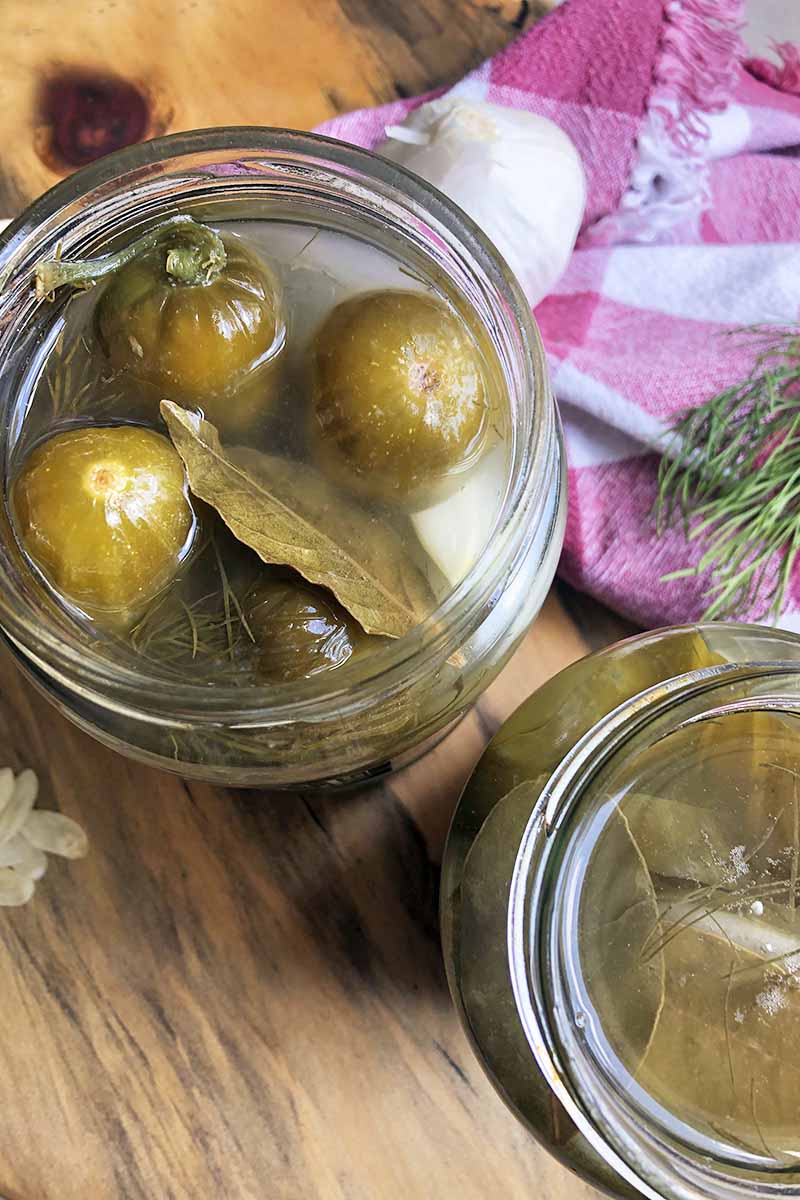
A few words on fermentation…
(Clears throat.)
After successfully producing a delicious, perfect batch of lacto-fermented pickles, I am still in no way an expert on the topic.
I bet you thought I was going to take that in another direction.

Though fermentation isn’t a complicated process, it’s wildly interesting and filled with many twists and turns along the way. Thankfully, it takes up to a week to make this particular recipe, which means I had seven days to research the topic and learn more.
I also wanted to make sure that I hadn’t just created a condiment that would grow into a salty monster and eat me.
That’s irrational, you say?
Wait until you pour a little salt and water over a vegetable, only to come back to it several days later to find it vigorously bubbling away as if someone had plugged it in.

Here’s what I’ve learned:
The classic vinegar method I’m familiar with isn’t the only route to righteous pickles. In fact, the heat used (when you boil the vinegar, water, salt, and sugar brine) actually reduces the vitamin content of the veggie. These are what’s commonly called “refrigerator pickles.”
With a natural salt brine, you get beneficial probiotic bacteria that increases the vitamin and enzyme content of the veggies, making them good for your gut.
You go, lacto.

One of the most rewarding parts of making these pickles at home was witnessing their metamorphosis. And I’m not just talking about when they go from vibrant verdant green to a deliciously dull olive. As those beneficial bacteria eat the cucumber’s sugars, lactic acid is released.
That’s the gentle sizzle and pop you hear (and bubbles you see). All of this turns the salt water into an acidic solution, and tada! Lacto-fermentation.
You can even try your hand at making a homemade salsa using this process!
I was always a straight-D student when it came to chemistry, but if my teacher had pulled out jars of pickles and salsa at the beginning of class, my report card might have looked a little different.
I could have become a famous chemist and solved all the world’s most scientific complications!
Eh, who am I kidding? I would have eaten the snacks and gone back to doodling…
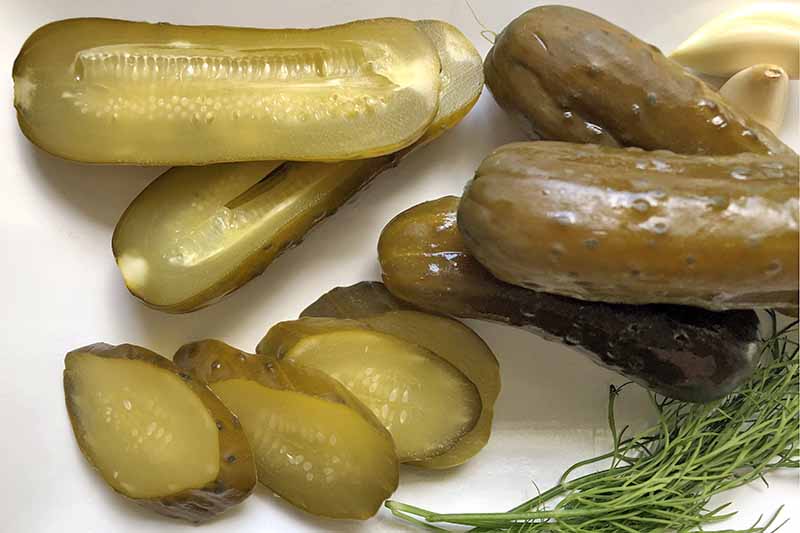
These homemade pickles are an addictive punch in the mouth of sour, salty, and garlicky goodness. They’re as crisp as can be, and grassy and fresh from the dill. It’s impossible to write about them without leaving my computer to head to the fridge for a quick snack.
And best of all?
With just a few ingredients, I got to watch plain old cucumbers transform into phenomenal pickles.
They grow up so fast.
Print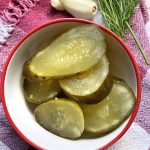
Homemade Lacto-Fermented Garlic Dill Pickles
- Total Time: 7 days
- Yield: 2 32-oz jars 1x
Description
Craving a briny snap? Make a batch of old-fashioned lacto-fermented pickles. They’re crisp, garlicky, and sensationally sour. Get the recipe now on Foodal.
Ingredients
- 4 tablespoons sea salt
- 4 cups filtered water
- Small bunch fresh dill
- 4 small dried bay leaves
- 4 cloves garlic, peeled
- 12 whole pickling cucumbers (about 2 pounds)
Instructions
- In a large bowl, dissolve the salt into the water. Clean the pickles well.
- Divide the dill, bay leaves, and garlic among the two jars, and then add as many cucumbers that fit comfortably – either leaving them whole or sliced first into thick rounds for pickle chips.
- Fill the jars with the salt water, leaving 1 inch of room at the top. Tightly screw on the lids, and allow the cucumbers to ferment at room temperature for 5-7 days, making sure you unscrew the lids every other day to release some of the built up carbon dioxide..
- Once the bubbling in the jars stops, taste the pickles and see if they’re crispy and fermented to your liking. Transfer the jars the fridge. They may be stored in the refrigerator for up to 2 months.
Notes
Nutritional information is approximate and includes sodium content of the brine.
- Prep Time: 5 minutes
- Category: Pickles
- Method: Fermentation
- Cuisine: Condiments
Keywords: pickles, garlic, dill, ferment, lacto-fermentation
Cooking By the Numbers…
Step 1 – Scrub and Prep the Cucumbers
First, gather and measure out all of your ingredients and a couple of quart-sized jars.

Thoroughly wash and the cucumbers under cool water and scrub them gently with a vegetable brush.
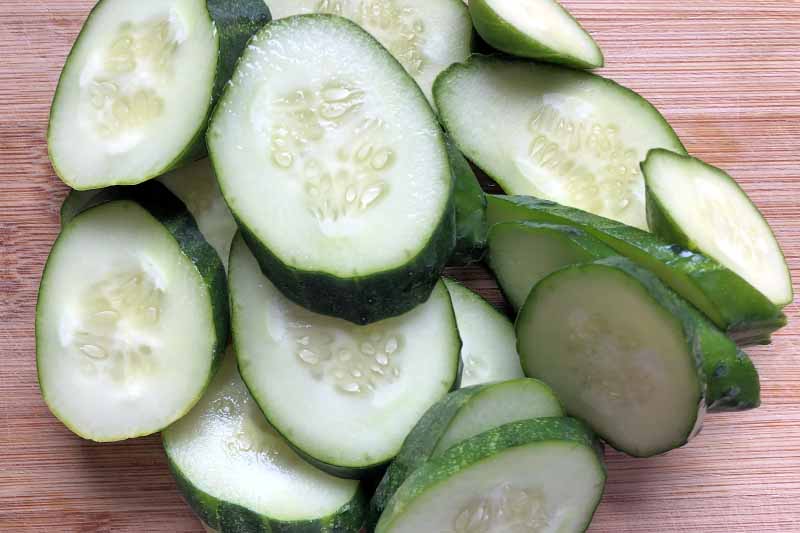
If you want to make pickle chips, slice them into 1/4-inch-thick rounds and place them in a separate container since they will ferment at a different rate than the whole ones. Otherwise, keep them all whole or slice them in half.
Step 2 – Make the Salt Brine
In a large bowl, dissolve the salt into the water. Make sure to use an iodine-free salt like sea salt (rather than iodized table salt), and filtered water that doesn’t contain any chlorine like tap water often does.
Step 3 – Prepare the Pickling Ingredients
Smash the garlic cloves with the side of a heavy knife, to release their flavor and allow them to easily slide out of their shells.
Divide the dill, bay leaves, and garlic among the two jars.

The bay leaves will add flavor, and they also contain tannins, which give you a crisp, crunchy pickle. You can also use grape leaves, oak leaves, horseradish leaves, or a tea bag. The tannins in these ingredients prevent the cucumbers from breaking down and becoming mushy.
If you don’t have mason jars, you can use any type of jar with a tight-fitting lid, like a store-bought pickle jar or a large mustard container. This a great way to reuse those empty glass jars before you recycle them!
Step 4 – Add Cucumbers and Water
To the jars, add in as many cucumbers as you can that fit comfortably. You don’t want them to be overly squished, but you also want them to be snug enough that they don’t float to the top.

Pouring slowly, fill the jars with the salt water, leaving 1 inch of room at the top.

Make sure the cucumbers are fully submerged in the brine. If you need to weigh them down, use fermentation weights, soapstone whiskey rocks, or a heavier vegetable end like a fennel bulb.

Jiggle the jars to remove any air bubbles before sealing them.
Step 5 – Screw on the Lids and Begin the Fermentation Process
Tightly screw on the lids, and allow the cucumbers to ferment at room temperature for 5-7 days.
Carefully (but quickly) unscrew and reseal the lids every day or two, to accomplish a quick release of some of the carbon dioxide that has been produced by the bacteria doing the fermenting.

This is called “burping” the jars. If your fermentation is bubbling vigorously, you can burp the jars up to twice a day.
While the cucumbers ferment, you’ll notice some bubbling and clouding. This is completely normal – it means the bacteria is doing its job.
Step 6 – Refrigerate
Once the bubbling in the jars subsides, this means that the fermentation has slowed down.
At this point, you can observe and even taste the pickles to see if they’re tangy and sour to your liking.
If you notice a pinkish or brown discoloration, mold, fuzz, a slimy appearance, or rotten smell, the fermentation has gone bad and you should discard the pickles.
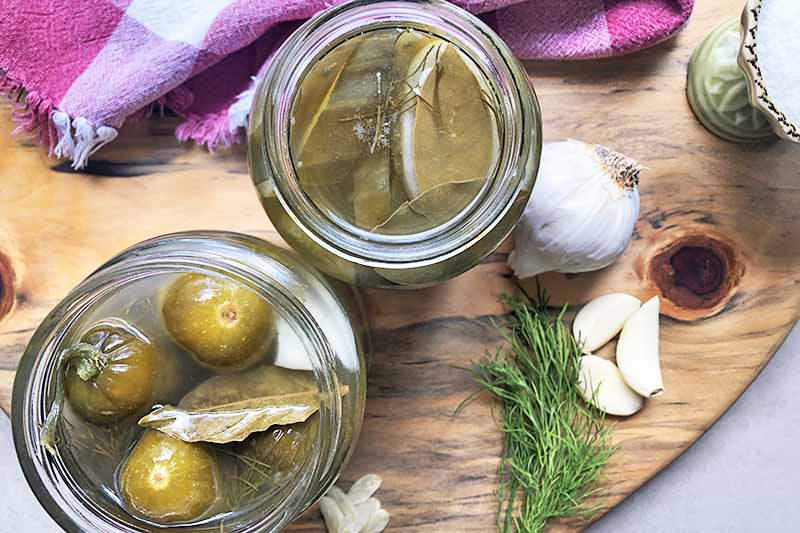
If the bubbling has stopped and the pickles look good, but aren’t as fermented as you would like them to be, leave them at room temperature for several more days and re-test.
If they appear to be fully fermented, but don’t taste as tangy as you were hoping, start over again with a new batch.
Once the pickles are fermented to your liking, transfer the jars the fridge. This will stop the fermentation process.
The pickles will keep for up to 2 months, but will lose some of their crispness over time, particularly if they’re sliced into chips.
It’s a Pickle Party and You’re Invited
I don’t know what it is about biting into a crisp, cool, salty-sour pickle that makes me want to fly into a frenzy of fermentation.
Now that I’ve stumbled into the world of natural salt brining, my mind (and jars) are brimming with possibilities.
From fermented beets to cabbage to squash, I’m seconds away from seeing if I can pickle my husband.

Become a fermentation fanatic with these gut-soothing recipes:
Are you familiar with fermenting? Share your finest success stories in the comments below! And don’t forget to give this recipe a five-star rating if you loved it.
Photos by Fanny Slater, © Ask the Experts, LLC. ALL RIGHTS RESERVED. See our TOS for more details. Originally published by Shanna Mallon on July 26, 2010. Last updated: July 18, 2023 at 9:08 am. With additional writing and editing by Allison Sidhu.
Nutritional information derived from a database of known generic and branded foods and ingredients and was not compiled by a registered dietitian or submitted for lab testing. It should be viewed as an approximation.
About Fanny Slater
Fanny Slater is a home-taught food enthusiast based in Wilmington, North Carolina who won the “Rachael Ray Show” Great American Cookbook Competition in 2014, and published her cookbook “Orange, Lavender & Figs” in 2016. Fanny is a food and beverage writer, recipe developer, and social media influencer. She was a co-host on the Food Network series “Kitchen Sink,” was featured on Cooking Channel’s longtime popular series “The Best Thing I Ever Ate,” and continues to appear regularly on the “Rachael Ray Show.”



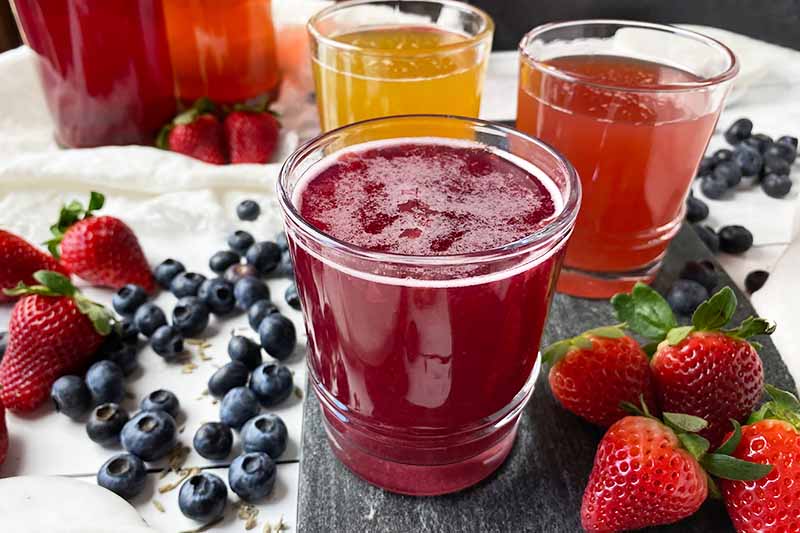

I’m excited to be writing the first comment on this post, because I am the Queen of Pickles. Seriously, I think pickles are one of the greatest things on the planet, and I am ashamed that I have never made my own. I have always been this way, ever since I was a little girl, and I have converted Will from a “pickle-picker” (as in picks them off burgers) to a full on pickle eater. It only took about the first three years of the relationship or so, but we’ve been enjoying pickle-laden relationship bliss ever since. I’ll note that it’s taken five years for me to finally come around to beer.
I think that perhaps pickles will be my first exciting food project in my new apartment.
Sure looks like the ones my grannie made.
I’ve always been the one in the family for crunchy, vinegary tasting food, namely pickles. And, when I worked for a short time at a chocolate store in the local mall, I went next door for a pickle or sauerkraut.
My holiday is over, I need to get to my pickling.
Glad you hear that you finally found some pickles that work for you. I’ve had a similarly strong aversion to bananas for years (more of a texture issue than a flavor one – I love them in smoothies and banana bread!), and keep trying little bites here and there to see if my taste buds have come around. Not there yet, but if I keep trying, maybe bananas and I will sort out our differences some day. LOVE pickles though – crunchy half-sour ones, that is. Not such a big fan of the soggy full sour pickles of the jarred variety. But these look great!
these look so great! i’ve been meaning to make pickles for seriously almost a year now and just haven’t gotten to it. maybe this weekend!
I feel the same way about olives the way that you do about pickles. In my mind, the occasional olive taste-test is a chance to determine whether or not I’ve truly grown up yet. And each time, the answer is no! But I’m very happy to hear that you’ve matured. 🙂
mmmm…
Hi, Shannalee. Good for you for overcoming your aversion and preserving it for months to come! I think food issues are sometimes really about personal growth, rather than taste…now if I could only learn to embrace sweetbreads (of the awful-offal variety) in their natural state.
Thanks for an engaging post,
Dan
Have you ever seen Aunt Bee make pickles on Andy of Mayberry. It’s a funny one. I love pickles, never thought to make my own, but even that would be new possibilities and if my husband eats them I’ll be amazed. He’ll eat nothing pickled whatsoever. But, then I’ll eat them all. It’s good to know they are actually serve as a health benefit.
I love pickles… but hate dill pickles. Would these be good w/out the dill? I would love to try them since they look so easy to make!
these look YUMMY!! no vinegar, eh? i’ll have to try it! i love making pickles of all kinds, esp beet ones!
I never made my own pickles but this seems so easy. What if it’s hot in my kitchen? Should I leave them in the fridge?
I’ve made my own pickles before but with different types of vinegar.. I didnt know you could just use water, I will have to give these a try!
Ahhhh … Jude and I LOVE pickles and just this weekend found a recipe to try on our own. But I feel much better experimenting on something you’ve recommended. Here goes nothing … 🙂
now I’m sad that I asked for pickling cucumbers to be omitted from my CSA box. I wonder if it is too late to have them added. These sound delicious. Can’t wait to try them!!
Niki, You should def try them without dill. Use the same method—water, salt, whatever herbs you want—and see how it goes!
JessieV, Pickled beets? That sounds like something I should try. I also want to try pickled carrots!
Whitney, Mmmm it’s the carrots that really got my attention. Soon!
Michele, If your kitchen is warmer than mine (seriously, mine’s like 60 degrees), you’ll probably just find that the pickles are ready sooner. Where I waited at least a week (sometimes even 8 or 9 days), you may only need to wait 4 or 5. Just keep an eye on them on the counter, and when they’re ready, you can stick them in the fridge.
Kristen, So simple, right? I’d love to hear what you think!
Kelley, The thought of you and Jude cooking together makes me smile. Hope you get to try this! And hope you LOVE it!
Jenny, I totally understand; I would have too probably. But honestly, I feel confident telling you now: get your hands on some and try it!
I have to try this recipe…it is so easy. And the results sublime. And now that it is grilling season, these pickles can go right beside the burgers. Or wait! On the burgers. Yes!
Wow, that sounds really wonderful! I’ll definitely make those when I get the chance.
Lynne, Oh my word. Pickles on home-grilled burgers? That sounds SO GOOD.
Jennifer, I hope you get to try these!
I’ve never actually thought to make my own pickles! Only in the past few years have I actually started to really enjoy pickles and even then I like the “fresh” kind. My boyfriend did make us pickled watermelon rinds recently though… talk about trying to make yourself like something 🙂
Evan, Pickled watermelon!? Not only have I never tried that, but I’m also super curious because I’ve never even seen it. Good for you for giving it a shot!
I like pickles. Fresh pickles are really nice. My mom made them sometimes when I was a kid. Yours look really good.
thanks, TJ!
so you don’t need to sterilize these or use preservatives? i’m still learning about these rules.
Lainey, That’s right. The idea behind this type of fermenting is that you don’t want to kill the bacteria because you WANT good bacteria (i.e., probiotics)!
I did it! I did it! I made them! I’m not going to post about it until I can taste one though. 🙂
🙂 Yesssss! And keep in mind, you can check on them along the way. I was talking to my mom the other day, and she was saying she likes hers much less salty than I do. It’s all adjustable. Good luck and can’t wait to hear how it goes!
Shannalee, I made your pickles a week or two ago, only I replaced the dill with some pricked hot peppers because spicy is so irresistible. They’re quite delicious!, although I have two observations: sliced cucumbers taste better, and, also, a white film is beginning to form in the jars. Is this harmless and beneficial like the similar strands in kombucha? Have you experienced anything like it during your fermenting forays?
Clare, Yay! So glad you tried this and that it turned out well! It’s great to hear your observations – when you say sliced taste better, do you mean sliced and pickled? I made one jar of sliced and one whole, and I ended up liking the whole better (which I totally didn’t expect)! As for the white film – it’s hard to say without seeing them, but it sounds like it’s normal. You made the pickles a week or two ago, but the film is forming now… are the pickles in the fridge? If so, the fermenting should be very slowed down; if not, I’d definitely put them in now. Hope that helps! 🙂
Shanna,
Due to the fact that I purchased pint-sized mason jars instead of quart, I had to cut my cucumbers in slices, in order to fit. However, I filled several jars, and in some of them I left the cucumbers whole. Where I live is very warm; I put the jars in the fridge after only a few days. I found that the whole cucumbers shriveled a little and didn’t retain their crunch. The sliced, however, did.
Ah, that makes sense, Clare! And good to know for anyone else in warm climates and/or with smaller jars!
Do you think this would work with regular large cucumbers sliced instead? (as I don’t have a wide variety to chose from where I live) Thanks.
Suzie, If you can find a jar big enough to cover them with liquid, yes! Actually this general concept can work for all kinds of vegetables!
830 mg. Sodium in 1/3 Pickle offsets the good gut benefits, IMHO.
★★★
Ah Gary, now I gotta go and tell 84 million Koreans that their kimchi sucks because it contains too much sodium. Drats.
As we explained in the notes on the recipe, our nutritional information provided is an estimate. For this recipe, the total calculation includes all of the sodium content of the brine. We haven’t done a study of the salt content actually contained within the pickles since we’re not equipped to do that, but most of the sodium is not actually absorbed by the cucumbers.
For comparison, if you look at a jar of Claussen kosher dills, each contains about 290 mg sodium per pickle.
Been making crock pickles long enough that I’ve graduated to a ceramic crock that holds 10 lbs. of pickles at a time. Have never been able to get fig leaves, but discovered Pickle Crisp a brand calcium chloride that does what it says. Consistently yields great pickles and worth a try. Oh yea, it’s really cheap.
You should cut the blossom end off to help keep them crisp. The blossom end contains an enzyme that causes the pickle to go soft. Also other vegetables are actually easier to ferment then cukes. They can be tricky. If your house is hot you need a higher salt solution, cooler you can use a lower. Bay leaves, black tea leaves, grape leaves, oak leaves, and mustard seed all work to help keep your pickles crunchy. Oh and the white film on top is normal and not harmful, just skim it off and as long as your food is under the brine all is fine… Just a few tips.